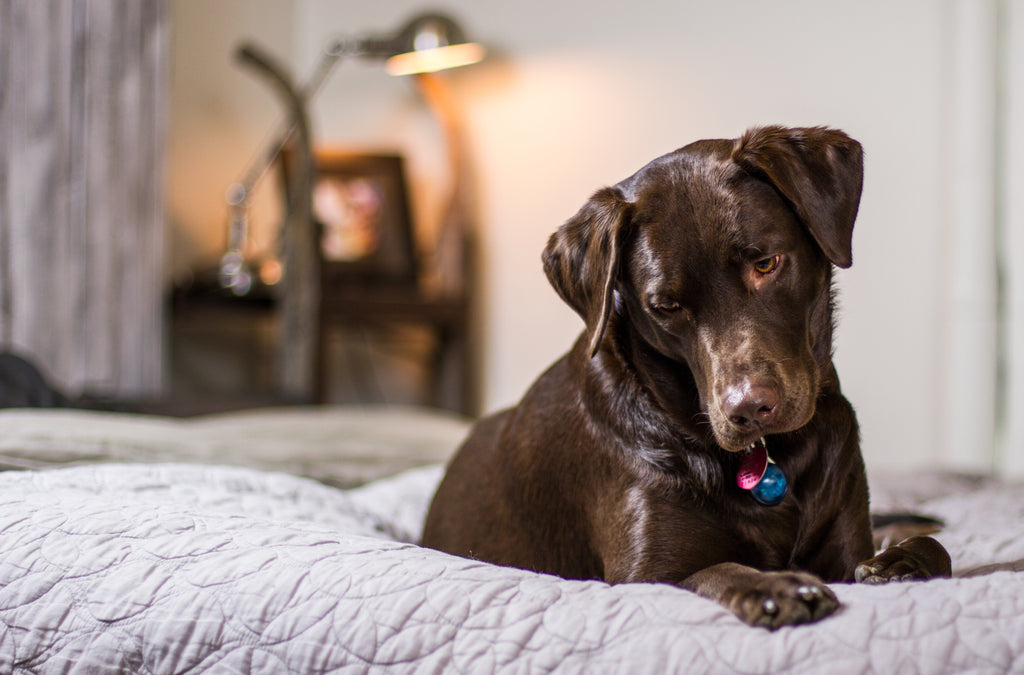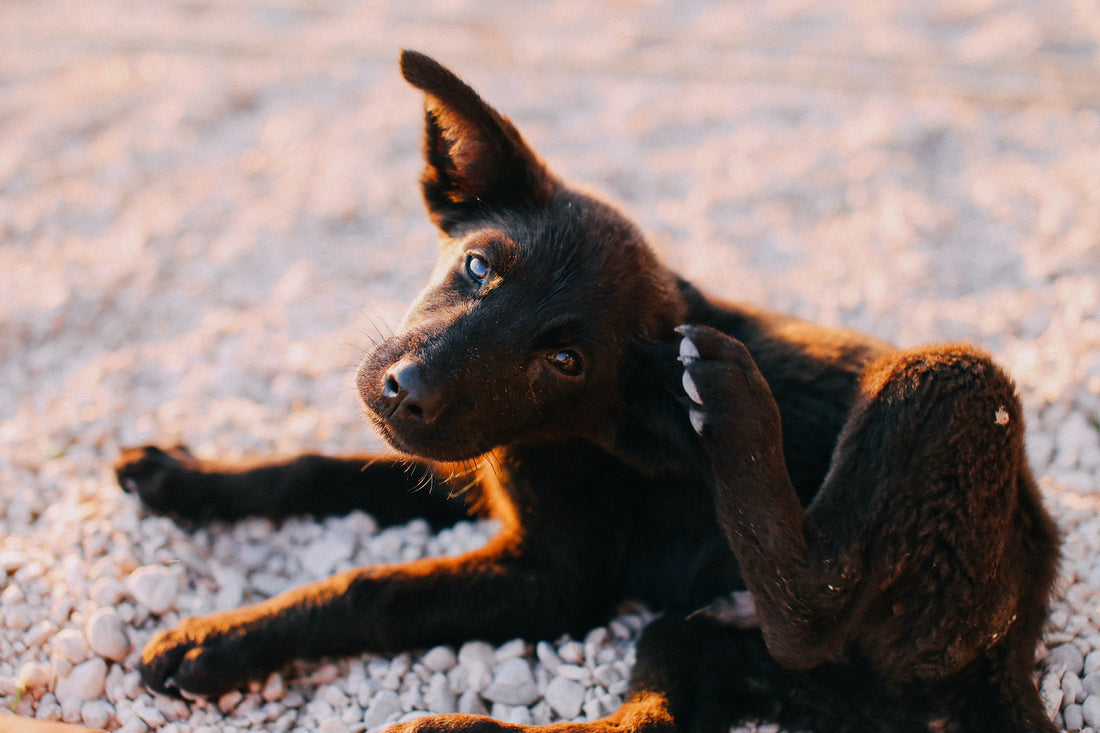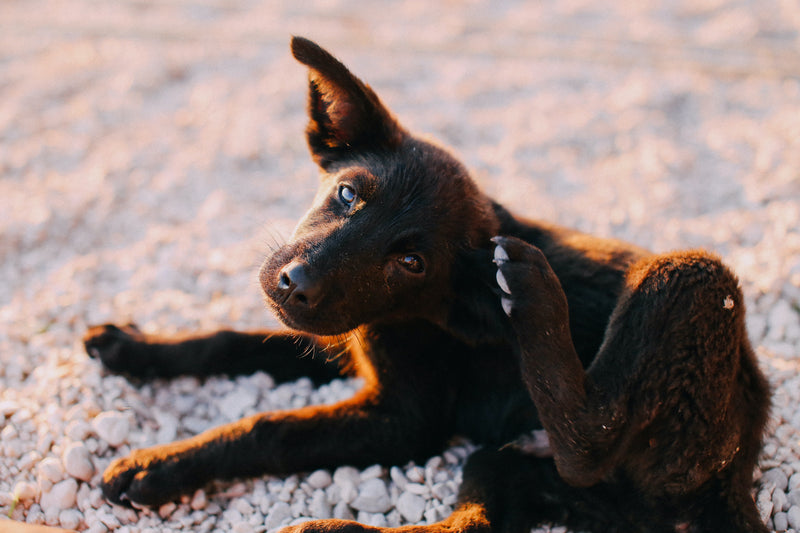Take a moment and think about what fleas actually are. Imagine them living on your head—infesting your hair, irritating your skin, laying eggs, biting, pooping. Is your skin crawling yet? It should be. Fleas are disgusting.
They have no place on your head, in your home, or on your pet. That's why we've put together this comprehensive guide on how to get rid of fleas once and for all. In this article, we'll discuss the three treatments you should implement: at-home solutions, over-the-counter treatments, and environmental treatments. We'll also talk about the importance of treating your pet and the environment to prevent fleas from ever coming back.
At-Home Flea Treatments
There are a few at-home flea treatments that you can use to get rid of the mature fleas on your pet. If you need immediate relief and you are unable to use a flea treatment for any reason (either you don't have some and can't get to the store, or your animal is too young or too small to use a flea treatment on) these are good, temporary solutions.
1 - Dish soap flea bath.
You can buy a special shampoo at the store, or you can make your own by adding a few drops of dish soap to warm water. Dawn dish soap is generally preferred by vets for this purpose as it doesn't leave any residue that might cause digestive upset when pets self-groom after treatment. When Dawn is combined with water, the chemical reaction compromises the exoskeleton that usually allows fleas to float. By giving your pet a bath with dawn dish soap, you are essentially drowning the adult fleas currently infesting your pet (but not killing any larva or eggs that might be on your pet). Be sure to thoroughly wet your pet's fur and work the shampoo in from the neck down. Let it sit for five minutes before rinsing.
Doing a dish soap bath can kill fleas, but it is not the most effective or efficient way to do so. It will also not prevent future flea infestations. So it’s a good solution for young dogs or those who can’t do a medicated flea treatment, but it isn’t a long-term solution.
2 - Use a flea comb.
This is a great way to manually remove fleas from your pet's fur. To use a flea comb, start at the neck and work your way down. Comb through each section of fur slowly and carefully. If you find any fleas, eggs, or larvae, remove them with the comb and dispose of them in soapy water.
While these at-home treatments might kill or drive away fleas, they won't be lasting treatments. They won't prevent the fleas from simply coming back from your pet's environment or ensure that all eggs and larvae are eliminated. In order to treat your pet completely, you'll need some more serious firepower.
Over-The-Counter Flea Treatments
There are a number of over-the-counter flea treatments available, and the most popular ones are:
1 - Flea drops (also known as a top spot treatment).
Flea drops are a topical solution that is applied to the back of your pet's neck. It works by killing the adult fleas on your pet's fur and skin. Because this is a treatment that is absorbed by your pet's skin, it is effective in preventing flea infestation for a much longer period of time after treatment. Top spot flea treatments are available over the counter at most pet stores.
Some popular brands of top spot treatment include:
- Frontline Plus
- Advantage II
- Seresto Flea and Tick Collar
Frontline Plus is a monthly treatment that starts working within 24 hours and provides continuous protection for 30 days. It is safe for use on puppies and kittens eight weeks of age or older.
Advantage II is a monthly treatment that starts working within 12 hours and provides protection for up to four weeks. It is safe for use on puppies and kittens seven weeks of age or older.
Seresto Flea and Tick Collar is a flea-drop collar that stays on continuously and starts working within 24 hours. It is often the most cost-effective form of flea control because a single collar provides protection for up to eight months. It is safe for use on puppies and kittens seven weeks of age or older.
2 - Oral medication.
Another option is an oral flea medication. This can be more convenient in the short term than topical flea treatments. It's often much more of a process to get your pet to sit still long enough to draw a bead of treatment down their spine. Oral medication, on the other hand, is a simple treat that many pets love to eat! Some popular brands of oral medication include:
- Capstar
- Comfortis
- Bravecto Chews (for dogs)
Capstar is an oral tablet that starts working within 30 minutes and provides protection for 24 hours. It is safe for use on puppies and kittens four weeks of age or older. These are generally used along with a topical treatment to help kill the biting faster (since those take hours to do their job, or as a quick 'don't bring fleas home' treatment when visiting dog parks, daycare, boarding, homes with other pets, and other potential infestation spots.
Comfortis is a monthly oral flea prevention medication for dogs and cats that is available with a prescription from a veterinarian. It is a chewable tablet that is taken orally, and it works by killing adult fleas. It’s safe for dogs and cats 14 weeks or older. This treatment starts working within 30 minutes and will protect your pet for a full month.
Bravecto is the top flea treatment recommended by the veterinarians we work with. It’s a flea and tick prevention medication for dogs that is available only with a prescription from a veterinarian. It is effective against a variety of pests including fleas and ticks, even those that may transmit diseases such as Lyme disease. Bravecto is safe for use in dogs 6 months of age or older, and it is available in different dosage sizes based on the weight of the dog. This treatment begins to work within hours after ingestion, and it provides protection against fleas and ticks for a full 12 weeks (3 months).
3 - Flea shampoo.
Flea shampoo is another option for treating your pet. It is a convenient way to kill fleas, but it only provides temporary relief. Flea shampoos are available over-the-counter at most pet stores. Be sure to follow the instructions on the package and apply them as directed.
Some popular brands of flea shampoo include:
- Tropiclean Natural Flea & Tick Shampoo
- Zodiac Flea & Tick Shampoo for Dogs & Cats
- Advantage Flea and Tick Treatment Shampoo
Tropiclean Natural Flea & Tick Shampoo is a natural and safe way to kill fleas and ticks. It is made with essential oils and provides protection for up to two weeks.
Zodiac Flea & Tick Shampoo for Dogs & Cats is a medicated shampoo that kills fleas, ticks, and lice. It is safe for use on puppies and kittens 12 weeks of age or older.
Advantage Flea and Tick Treatment Shampoo is a medicated shampoo that kills fleas, ticks, and lice. It is safe for use on puppies and kittens eight weeks of age or older.
If you're dealing with a flea infestation, there is a very good chance that the fleas are not only infesting your pet but also the places they sleep and spend most of their time. For most of us, that means when our pet has fleas, a portion of our home has fleas.

Environmental Flea Cleaning Protocols
Treating your pet is important, but it's not enough. Any fleas you find on your pet are likely to be adult fleas. About 95% of flea eggs and larvae fall off of your pet and into whatever environment they happen to be in. That means your dog’s bed, your cat’s favorite hideout, any carpet, rug, towel, or couch that your pet has lain on, or anywhere else that is warm, comfy, and soft that your pet hangs out around, is probably infested with more fleas. Grossed out yet?
Treating your pet will kill only about 5% of the total infestation. If you want to get rid of pests, environmental flea treatment and care are absolutely vital. So along with using insecticides on your pet, the environment must also be thoroughly cleaned to remove as many of the adult fleas, eggs, larvae, and pupae as possible. This is the only way to keep the infestation from coming back.
If you have fleas in your home, a good vacuum will be your new best friend. Vacuums with a beater-bar brush are incredibly effective at removing both adult and immature fleas from carpets and furniture. Vacuuming also disturbs carpet fibers and exposes immature fleas, larvae, and cocoons to environmental flea treatments.
You'll want to vacuum the places your pet spends the majority of their time—like their bed or favorite chair. Make sure to vacuum well under the furniture too. Flea larvae will try to get away from the light by crawling underneath couches, chairs, tables, or into any other constantly dark places.
Fleas can and will try to escape the vacuum container if they can. To mitigate this, you can cut up a flea collar that your pet would normally wear into 2-inch long pieces and put them in your vacuum bag or canister before starting. This will help kill the fleas and prevent them from crawling out. You should always dump the vacuum bag or canister in an outside trashcan immediately after you finish cleaning.
Note: If you want to take your cleaning game to the next level, you may also consider steam cleaning your carpet as well. This is another layer of flea removal that can help to rip up any stubborn cocoons and larvae hidden in matted carpets or particularly dirty areas.
Additionally, be sure your pet’s bed and any blankets they may use are thoroughly washed in hot water. Do this weekly to ensure no flea infestation can take root.
Environmental Flea Treatments
Once you've thoroughly cleaned your pet's environment, now it's time to mop up any remaining fleas with an environmental flea treatment. There are a number of different environmental flea treatments available, but the two easiest to use are powders and sprays.
- Zodiac Flea & Tick Powder
- Tropiclean Natural Flea and Tick Spray
Powders are a popular choice because they are easy to use by sprinkling over your pet's area. Leave the powder undisturbed for at least 60 minutes, then simply vacuum it up. And that's it! Flea powder is a relatively inexpensive, and effective final treatment to get rid of an environmental flea infestation.
Sprays are another popular choice because they can be used to treat a large area at once. This type of environmental flea treatment saturates the carpet with the appropriate insecticides to eradicate current infestations and prevent future infestations. You can use flea spray by misting the treatment over the infested area, then let it dry for about 2 hours.
A note on outdoor flea control:
Especially if you live in the country, fleas can be a real problem for pets that spend time outside. While you don’t need to treat every inch of your property, covering some of the areas where fleas like to hang out can reduce the amount and severity of future infestations. Fleas like to congregate in shady, warm (but not too warm), slightly moist areas like under trees and bushes, under decks or raised patios, and in lush, well-watered grass. Treat these areas with a pest control yard spray. Also, be sure to wash outdoor bedding frequently in hot water. Clean up any areas where water collects and keep plants and bushes well-trimmed to discourage infestation. Covering those areas and any dog house or run is generally enough to make a significant difference.
If you have a serious flea infestation that regular cleaning and treatment can not control, you may need to call a professional pest control company. They will be able to treat your home and get rid of the fleas for good. For anything less than the most severe infestation though, we carry environmental flea treatments to round off your flea extermination efforts.
Helping Your Pet Recover From Fleas
Once the infestation has been cleared, you can begin to help your pet feel better. Because a flea bite can continue to itch for up to 14 days, getting rid of the fleas won’t stop the scratching. Your pet’s skin will undoubtedly be damaged and irritated by their ordeal. That’s why, at this stage, it’s a good idea to apply a good amount of over-the-counter relief.
The most common skin condition to affect dogs and cats is flea allergy dermatitis—red, inflamed skin that extends beyond the localized bite and causes extreme itching. Many of the same solutions for relief from this itching will also help with the discomfort brought on by summer yeast overgrowth and dry skin, so we'll talk about those products in a moment.
Things like Dr. Golds Hot Spot relief will be a lifesaver for your pet and make their recovery much more comfortable.
Oh, and one last thing to think about. Where there are fleas... there are often worms! If your pet has gone through a flea infestation, be on the lookout for symptoms of worms. We have an article that can walk you through potential symptoms of worms in your pet, and how to go about treating them.
Wrapping Up
Fleas are a common and pesky problem for pets and their owners. By implementing a combination of at-home, over-the-counter, and environmental treatments, you can effectively get rid of fleas and prevent future infestations. It is important to follow the directions and precautions for each treatment and to treat both your pet and their environment to ensure thorough and lasting results. With the right approach, you can say goodbye to fleas and hello to a happy, healthy pet. If you have any more questions on fleas and how to get rid of them, give us a call or come on into your local Kahoots! We're always happy to help.


